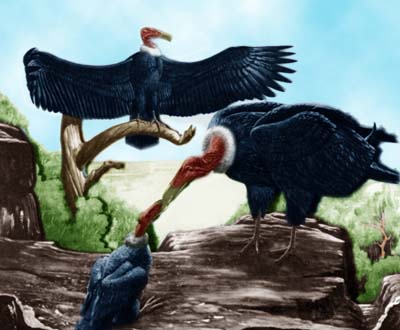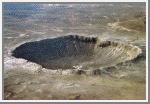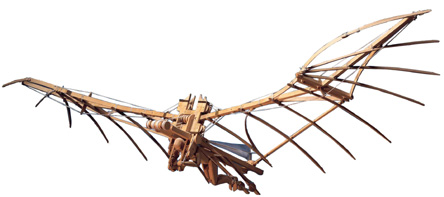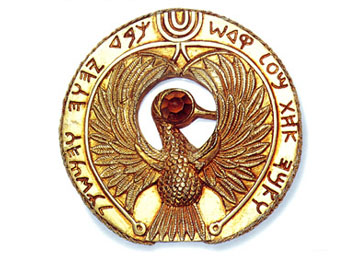
Throughout most history and almost all cultures there has been tales, stories, and legends of giant birds. I have heard many of the stories myself, although in real life, except for the incident as a young boy I mention at the bottom of the page that transpired under somewhat mitigating circumstances, the largest living flying bird I ever saw personally (as an adult) was a California Condor with a wingspan of around nine feet. I have seen, and many times over because I have found myself going back and looking at it again and again ever since my Uncle took me there as a kid, the skeleton of the Teratorn found in and now on display at the La Brea Tar Pits in Los Angeles, California. When alive that particular bird had a wingspan somewhere between fourteen to sixteen feet.
There continues to be reports of huge birds and flying creatures being sighted around the country to this day, such as the sightings of Thunderbirds Over Illinois, giant avians from Native American lore that rode the winds and updrafts ahead of moving storms to the so-called Cloud Dragons over Texas, reputed to be fifty-foot wingspan pterosaurs. However physical evidence of those sightings, from photos, to footprints, to feathers, is usually not forthcoming. There is evidence in the fossil record of the huge pterosaurs as well as giant feathered birds capable of flying with wingspans as large as twenty-five feet, and, in relation to the birds, not necessarily that far back in time. As reported in the article presented below by David Rhys the feather size from such a bird is estimated to have been 1.5 meters long (60 inches); and 20 centimeters wide (8 inches). Such a size would make the feather at least five feet long, similar in length to the one described as coming from the American southwest in The Boy and the Giant Feather.
In the flood plain of the Willamette Valley near Portland, Oregon at a place called Mill Creek Park a large bone was found that the excavators first identified as the leg bone of an elk. However, further examination revealed it to be the upper wing bone of a bird. The size of the bone meant that the wing span of the bird would had to have been well over twelve feet, and probably closer to fourteen to sixteen feet. Other recovered elements include both quadrates and other cranial bones, partial dentaries, partial sternum and other partial post-cranial bones, and a series of cervical and thoracic vertebrae. Given the size of the bones even the giant condor was small compared to this specimen.
Bird humerus originally thought to be a leg bone of an
elk, measured against a six-inch rule.- Click image for
larger view as well as additional supportive evidence.
Archeologist Alison Stenger, the project leader at the evacuation site, took the bones to the La Brea Tar Pits and the Natural History Museum of Los Angeles County to compare them to their collection of bird skeletons. They identified the bones as that of a Teratorn. These large birds had very large wing spans, and, though they could weigh over 170 pounds, they could still fly. A similar Teratorn specimen found in Argentina has the largest wingspan of any known bird, at over twenty-four feet.
Finding a bird bone in such good condition is of particular significance because bird bones don't usually last as long as mammal bones. In order to fly, birds need to be as light as possible, and their bones are usually very thin and fragile. The bones of a horse or bear need to be strong to carry the weight of these large animals, so they are more likely to survive predation, deposit, and burial.
A partial humerus (wing bone) of a Teratorn was discovered by San Bernardino County Museum paleontologists near Murrieta, Riverside County, California.
The discovery was made by Quintin Lake, senior field paleontologist for the San Bernardino County Museum. The fossil was described by Kathleen B. Springer, Senior Curator of Geological Sciences, and Eric Scott, Curator of Paleontology, also of the San Bernardino County Museum, working closely with fossil bird expert Kenneth E. Campbell of the Natural History Museum of Los Angeles County. The new find was announced in a Smithsonian Institution publication, "Avian Paleontology at the Close of the 20th Century."
The fossil from Murrieta suggests a wingspan of at least eighteen feet. Besides the Murrieta site, scattered and fragmentary fossils of the Teratorn have been discovered in many places throughout the desert-southwest, including Nevada, the Anza-Borrego Desert in California, and the Arizona Strip. Also, beyond the the desert and Oregon as cited above, Teratorn remains have been found as far east as the state of Florida. Recently the former presence of California Condors in upper New York state was confirmed by Richard Laub of the Buffalo Museum of Science and David Stedman of the New York State Museum. The condor bones were found in an Ice Age layer at the Hiscock Site in Genessee County, New York, and, until the fossils were discovered, it was believed that the condors closest habitat was in Florida. Fossil bird bones, a rare find on similar sites, are abundant on the Hiscock Site. About 30 species of birds have been found, many of them extinct or no longer found in Western New York. In that the Teratorn and Condor seemed to have shared similiar haunts elsewhere it can be presumed that Teratorns ranged as far northeast as present day New York as well.
Scott added, echoing a similar tone to one of the paragraph above, "Fossils of large animals from Murrieta are usually from extinct mammals — mammoths, mastodons, ground sloths, large horses and other animals of that size. Birds are very rare because their bones are thin and fragile and don’t often preserve well. Quintin’s fossil is most unusual in that context. We’re glad he has such good eyes!"
The specimen has been cataloged into the collections of the San Bernardino County Museum where it will be preserved for future study. A variety of fossils from southern California, including fossils from Murrieta, are presently on exhibit at the Museum.
The article below appeared in Bioscience, December 1980:
Argentine scientists' have unearthed the fossil remains of what Seems to be the world's largest known flying bird, Argentavis magnificens. With a wingspan of 25 feet, the bird measured' 11 feet from beak to tail, and weighed in at l60 to 170 lbs. Its first wing bone, the humerus, was approximately 22 inches long.
Paleontologists Kenneth E. Campbell and Eduardo P. Tonni identified the fossil remains at Argentina's La Plata Museum. Working with leg, wing, and skull bones, Campbell and Tonni, have tentatively concluded that the enormous bird probably did more soaring than flapping. They admit that it seems initially unlikely that a bird of that size could even get off the ground, but believe that the size of the wing bones and their markings indicate that Argenravis magnificens did fly. "It has the right size wing bones, and it has the markings on the wing bones of secondaries, a type of flight feathers," Campbell said. "It's unlikely that a bird would have feathers and wing bones suitable for flight if it didn't fly."
In the past, there have been larger birds and larger flying animals, but no larger flying birds. Pterosaurs, giant flying reptiles, were the biggest creatures to take off; one pterosaur found in Texas had a wingspan of 30 to 33 feet. The largest previously known flying birds were the North American Teratorn with a wingspan of sixteen feet.
Based on his studies of another teratorn fossil, Teratornis merriami (the skeleton above), Campbell believes that the teratorns were predators. "The long, narrow hooked beak and the type of jaw mechanism found in this species are similar to those that would be expected of a bird that grabbed small animals with its beak and swallowed them whole," he said.
Copyright 1991, Laura Cunningham
The next article is from the Geoscience Research Institute, Origins 7(2):87-88 (1980), by David Rhys.
Recently the Los Angeles County Natural History Museum displayed parts of a skeleton of the biggest known bird that ever flew. Looming over the entrance hall, a black silhouette of Argentavis magnificens spans its wings over 8 m and stands 3.5 m from tip of tail to end of beak. This is almost twice the size of Teratornis merriami which, until now, had been considered the largest size to which flying avians could evolve. Argentavis magnificens (new genus and species) has now wrested the title of "World's largest flying bird" from Osteodotornis orri, the gigantic marine bird from the Miocene of California.
E. Tonni and R. Pascual of the National Museum of La Plata, Argentina, uncovered the fossil remains of A. magnificens from the banks of Salinas Grandes de Hidalgo in the Argentine province of La Pampa, 400 miles SW of Buenos Aires. Their collection included portions of the skull, the coracoid, the left humerus (incomplete), a portion of the ulna and right radius, the right tibiotarsus, one end of metacarpal II, a portion of metacarpal III, and a shaft of right tarsometatarsus.
Systematics: Order. Accipitriformes
Family. Teratornithidae
New genus and species. Argentavis magnificensEtymology: Greek teretos (wonder) and ornis (bird)
Latin argentum (silver) and avis (bird)This discovery did not come to the attention of the international scientific world until K. E. Campbell, curator of the Los Angeles County Natural History Museum and specialist in teratorns of Rancho La Brea, visited La Plata's Museum and with Tonni began a detailed study of the collected fossils. Their results have now been published by the Los Angeles County Natural History Museum.
The fossils were found in Argentina's central plain which is characterized by a flat, semi-arid topography, an open grassland with an abundance of fossil herbivorous animals. A large number were rodents on which the A. magnificens is thought to have fed. This latter supposition is based on studies of jaw articulation in comparison with recent similar birds. It is further supposed that the heads were not naked as are those of vultures, but covered with feathers.
The large wing size would limit this bird to more open areas, as maneuverability around trees and shrubs would seem difficult. Feather size is estimated to have been 1.5 meters long (60 inches); and 20 centimeters wide (8 inches). It is not presently known if this Teratorn actively flew by flapping its wings or if it mostly soared as do present-day condors.
Further expeditions are planned to Argentina to search for additional fossils of this most magnificent bird.
© 1980 Geoscience Research Institute. All rights reserved.
More recently, as late as Wednesday October 16, 2002, in an article published in the Anchorage Daily News, and also picked up by the wire services, reported "a giant winged creature like something out of Jurassic Park" sighted several times in Southwest Alaska. A pilot that spotted the creature while flying passengers to Manokotak, Alaska, calculated its wingspan matched the length of a wing on one side of his Cessna 207, about 14 feet. Other people have put the wingspan in a similar range.
The Associated Press passed on much of the same story stating: "Villagers in Togiak and Manokotak say the huge bird has a wingspan of about 14-feet -- the size of a small plane." Reported as well was a sighting that occurred the previous Thursday, October 10, 2002, when a 43 year-old heavy equipment operator named Moses Coupchiak saw the bird flying toward him from about two miles away as he worked his tractor. "At first I thought it was one of those old-time Otter planes," Coupchiak was quoted as saying. "Instead of continuing toward me, it banked to the left, and that's when I noticed it wasn't a plane."
The actual related articles by the news services and newspapers have since come down due to the length in time since the reported incident occurred, however reproductions and facsimiles (many with personal comments and updates) have shown up all over the net and can easily be found by going to the Google search engine. They can also be linked through by clicking HERE.
As to the question have I seen or come into contact with a bird of such large size that it would require a feather as big as the one I mention, I cannot answer with all certainty. However, the following may add some insight as to IF and why of the possible uncertainty:
One day as a young boy I wandered off into the desert unescorted. When my uncle found me missing he went searching for me. Years later he told me the distance I traveled that day, from the point I started to the location he found me, was way to far for me to have covered given the time, especially considering the level of my own abilities, the terrain, heat of the day, etc. He told me he had tracked me some distance quite clearly, then my tracks suddenly just ended as though I had disappeared into thin air. Knowing I didn't have a large supply of water or any at all he continued to look in areas he thought I might seek out and just happened across me --- many, many miles from where he had last seen my tracks. How I got there he couldn't say with any amount of certainty. However, he told me, and he kept it a secret from his wife even to the point of burning my shirt, that my shirt below both shoulders as well as part way down the back and along my sleeves were punctured in spots and appeared to have what he called grip marks on them. So too, my skin had red abrasions almost like minor scratches as though my arms had been clutched by something. He told me he was sure I had been carried off and if he hadn't happened across me I may had been carried off even further, maybe even never to be found.
In that my uncle was not able to get me to tell him verbally --- OR I was unable or unwilling to put into words my experience of what happened that day --- my uncle suggested I sit down and draw whatever pictures came to mind that related to the event. All of those drawings are long gone as are any finite memories of same, except for one. I remember it clearly as if only yesterday because of the striking comparison my uncle made between one of my drawings and an ink and watercolor drawing by Leonardo Da Vinci. They were nearly identical, desert landscape and all. The major exception was that where Leonardo's drawing depicted a lake with a shape similar to a bird, my drawing, although having a similar shape, was instead, a SHADOW of a giant bird.
Leonardo Da Vinci: Bird's-Eye View of a Landscape. 1502.
Pen, ink and watercolor on paper. Windsor Castle, Windsor, UK
The drawings my uncle had me do came about after a series of unfortunate events.
When I was a young boy my mother became very ill. Soon she began spending more and more time time in the hospital. Eventually she died there. Before she was admitted full time, as she got closer to the point where she could no longer independently tend to her own personal needs let alone fulfill day-to-day activities required of a mother of three young boys --- and my dad continuing to work longer and longer hours in order to meet mounting medical expenses --- my two brothers and myself were shipped off to stay with relatives and friends. First a day at a time, then overnight, then weeks and months at a time.
I ended up living with a couple that just happened to be visiting neighbors. Before my father knew it, without his apporval or authorization, they took me to India, albeit with the unintended privilege of me meeting the venerated Indian holy man, the Bhagavan Sri Ramana Maharshi. See:
SRI RAMANA MAHARSHI: THE LAST AMERICAN DARSHAN
RECOUNTING A YOUNG BOY'S NEARLY INSTANT TRANSFORMATION INTO THE ABSOLUTE DURING HIS ONLY DARSHAN WITH THE MAHARSHI
Unconnected with any of the above events, within months of my return and still a very, very young boy, a dear and close relative committed suicide from the blast of a shotgun he stuck in his mouth. Within minutes I personally stumbled upon the aftermath. During the ensuing milieu I got caught up in an auto accident wherein I was rendered unconsious and found wandering in the desert all alone. During that trek lost across the desert a series of incidents led me to a near carcass of a dying coyote, a coyote easily twice the size of any normal one, an incident that ended with startling results. (see) That inturn was then followed by a two year-plus blackout period of any memory from my mother's death forward to the end of that two year period.
My uncle, because of the blackout period and concern with "how my brain worked" --- or didn't work like everybody else's as the case may be --- along with the fact I did not talk much, for reasons unexplained at the time, took me high into the mountains of the Sierras to meet with a man of great spiritual Attainment by the name of Franklin Merrell-Wolff. After our meeting and without me being within earshot, Wolff and my uncle talked a long while. Following the several hours drive after leaving Wolff's mountain compound I was tired and wasted and fell asleep for what seemed like forever.
What followed after I woke up I cannot confirm had anything to do with Wolff except from my own suspicions. It could have been because my uncle was an artist and it would be an easy ploy for him to work it in, but, following the several hours drive after leaving Wolff's mountain compound and my long sleep, within minutes of me waking up --- and continuing on for years afterwards --- my uncle had me make simple free-form drawings in cartoon or comic book narrative style of what was going on in my head. Then we would sit down and go over the drawings verbally, with me explaining in my own words what I drew and the why of my thoughts behind their visual content. In the process of those discussions my uncle either took notes at the time or wrote notes later about my drawings and what I said.
AND NOW THIS:
Why all the fuss about giant flying creatures, giant birds, and giant feathers, and all somehow and in someway related back to the Wanderling?
Basically, the Wanderling's uncle stated many times that he felt the reason for his destiny and fascination regarding all aspects of giant flying creatures went back to an incident that involved the fly over of a giant airborne object that the Wanderling witnessed as a young boy. The object, of an unknown nature and an unknown origin, was seen by literally thousands of people along the coast of California barely three months into World War II. Eventually to be called the Battle of Los Angeles, the incident is mostly forgotten now. However, during the early morning hours of February 25, 1942 the whole city and surrounding communities were in an uproar as thousands of rounds of anti-aircraft shells were expended in an attempt to pull down whatever it was in the sky that night. The slow moving object, said to be as big or bigger than a Zeppelin, was caught in the glare of the searchlights from Santa Monica to Long Beach and seemed impervious to the the constant barrarge of shells. It eventually disappeared out over the Pacific after cruising along the coast and cutting inland for a while. The huge object was never clearly explained and was basically hushed up without response from the authorities.
TALON AND SCRATCH MARKS FROM THE GIANT BIRD
|



Compare the Teratorn skeleton above with Leonardo Da Vinci's flying machine from the 1500s
THE ABOVE GRAPHIC FROM:
DA VINCI: Did He Fly?

